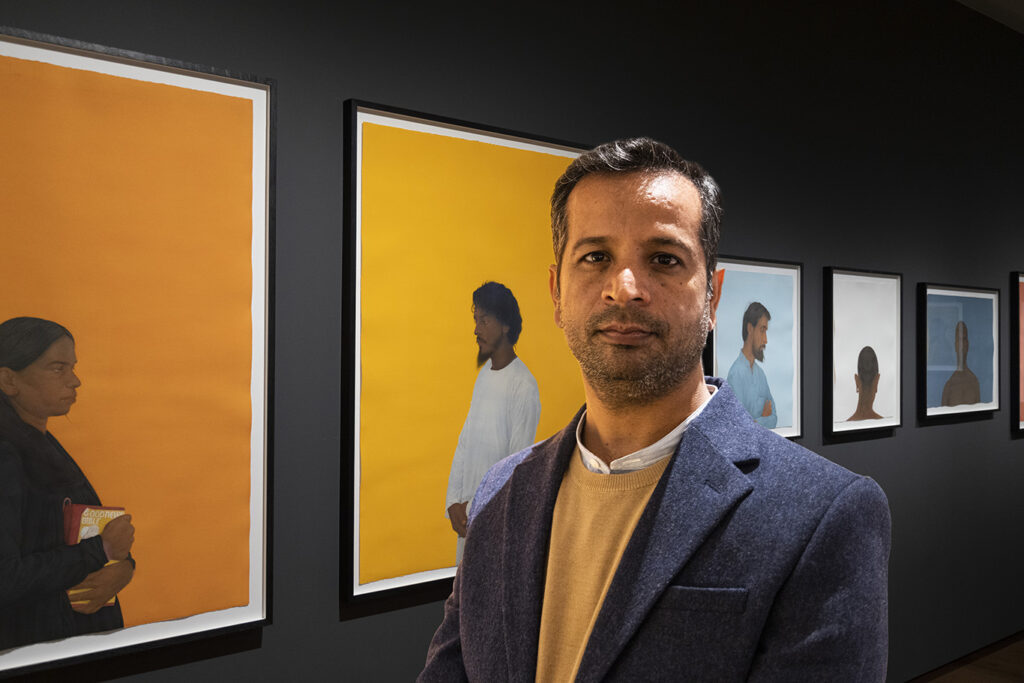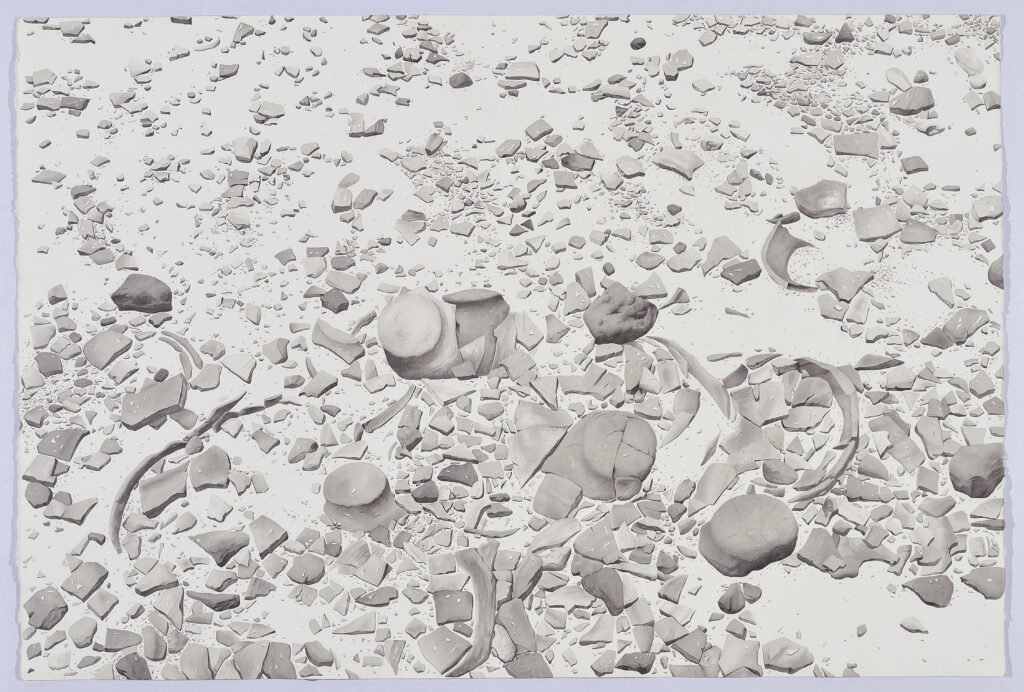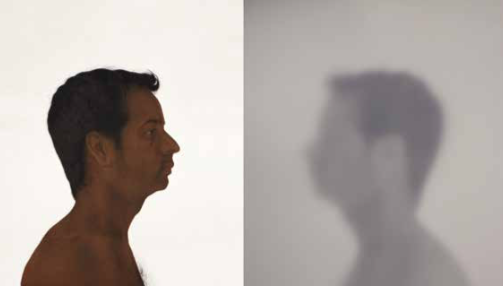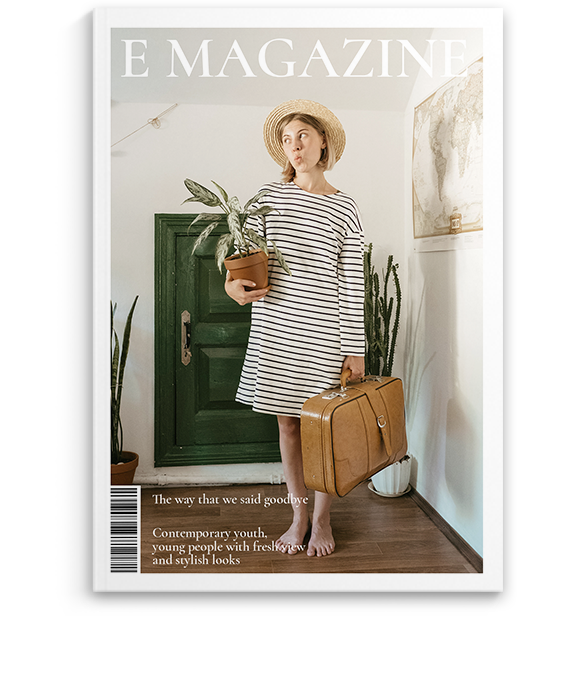Ali Kazim: Suspended in Time

Each of us has a unique relationship with time. It is one of the most important relationships we have throughout our lives. It is the measurement by which we judge our lives. We remark how slowly or quickly it moves. However, few of us stop long enough to face it on its own terms. To look time in the eye, so to speak. To discover what it wants of us or what it wants to tell us.
Ali Kazim’s exhibition, Suspended in Time, provides a rare opportunity to look time in the eye, so to speak
Suspended in Time, Ali Kazim’s exhibition at the Ashmolean Museum in Oxford, UK, provides a rare opportunity to do precisely this. It demands that we pause for a moment, to step out of the dazzling white halls of the museum into the dark quiet of the gallery.
It’s as if time asks you to sit for a moment and talk.
The works on display have been selected from Kazim’s career as one of South Asia’s most well-known contemporary artists. Each piece reflects the themes on which he was concentrating at the time – faith, devotion, pain, futility, loss, joy and rapture – sometimes a combination of these in a single work. The exhibit includes works inspired by Kazim’s time at Oxford’s Classical Art Research Centre in 2019, with the original artefacts or art displayed alongside Kazim’s interpretation or reimagination of them.
The works on display have been selected from Kazim’s career as one of South Asia’s most well-known contemporary artists
Two works dominate the exhibit, the first from Kazim’s now-iconic Ruins Series which depicts a neutral, desolate, landscape littered with potsherds and created using pottery fragments traced on paper and then carefully water-coloured.
Two works dominate the exhibit, the first from Kazim’s now-iconic Ruins Series which depicts a neutral, desolate, landscape


And then, there’s the matter of the birds.
Kazim’s Conference of Birds revisits a Persian poem by Farid ud-Din Attar. The poem describes all of the world’s birds assembling to choose a king. Being unsure of who to select, the wise hoopoe suggests they go in search of the Simorgh, a mythical bird who will advise them. The hoopoe warns of the dangers of the journey, predicting that many will not make it.
And yet, despite this, they begin.
Almost all of the birds do die. Some of thirst, heat or illness. Some are violently swept away; others eaten by wild animals. Only 30 make it to the end.
And yet, despite knowing this futility lay ahead of them, they began. The courage of the 300 allowed the 30 to arrive. This is the epicentre of the work.
Kazim’s Conference of Birds is a massive, five panel installation taking up half of one gallery wall. It was originally displayed at Allience Francaise de Karachi in 2019 for the second edition of the Karachi Biennale. Later, it was replicated and displayed as part of the Zinda-dil-a’an-e-Lahore Billboard Project during the Lahore Biennale in 2020 on a massive billoard at Mini Mart

Kazim’s Conference of Birds is a massive, five panel installation taking up half of one gallery wall
The observer could be forgiven, at first glance, for believing that this work is a story about the one. The hoopoe soaring unafraid into the final panel. But it is not. Kazim’s attention on every bird that set out reflects the fact that he believes that, as the exhibit label explains, “the entire flock was responsible for the courage necessary to start the journey…Not everyone makes it in life, but everyone deserves to be remembered.”

In Kazim’s work, the stark contrasts that we live with – life and death, success and failure – dissolve. Like the 3,000 air-dried, clay birds, Kazim cast and placed at an abandoned brick factory for the Lahore Biennale. Left exposed to the elements, the birds disintegrated back to the earth. To observe this is to, at once, sense both the beauty and futility of living in time.

Kazim cast and placed 3,000 clay birds at an abandoned brick factory for the Lahore Biennale. Left exposed to the elements, the birds disintegrated back to the earth
All of Kazim’s work lend themselves to stillness, silence, and reflection yet it is unusual to also be handed a reason to pause long enough to look at a piece of art, much less absorb it or let it whisper to us what we need to hear. But, Conference of Birds gives you this invitation by incorporating a 23-minute recital by Ali Asghar Asha and music by Khawar Jawad singing the poem in Farsi. It is a completely different experience to sit and observe the work with them than to brush past it on our way to the next piece.
All of Kazim’s work lend themselves to stillness, silence, and reflection yet it is unusual to also be handed a reason to pause long enough to look at a piece of art

When you interact with both the sound and the painting, you begin to feel, as Albert Einstein put it, “that the distinction between past, present, and future is only a stubbornly persistent illusion”. Suspended in time, you begin to sense the depth and expanse under the fritter of our every day.
This is the magic of Kazim’s exhibition. It appeals to both the trained and untrained eye. It appeals to historians and contemporary art enthusiasts. There are few contemporary artists through whom we get a sense of our place in it all. Through whom we see what it means to exist – and then not exist – and how we work with time throughout our lives. But Kazim is one of them.
This is the magic of Kazim’s exhibition. It appeals to both the trained and untrained eye
And emerging from the dark gallery back into the vast brightness of the hall you take with you the sense and assurance that nothing is lost even if, in the end, everything is lost.
More than anything else, Kazim’s work gives us the courage to begin anyway.







MUHAMMAD AMIR Ali
Such a great Pakistani contemporary artist his work is so realistic and inspiring 😍👏